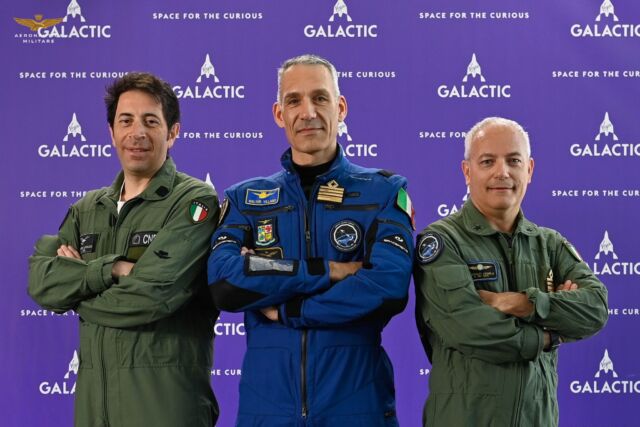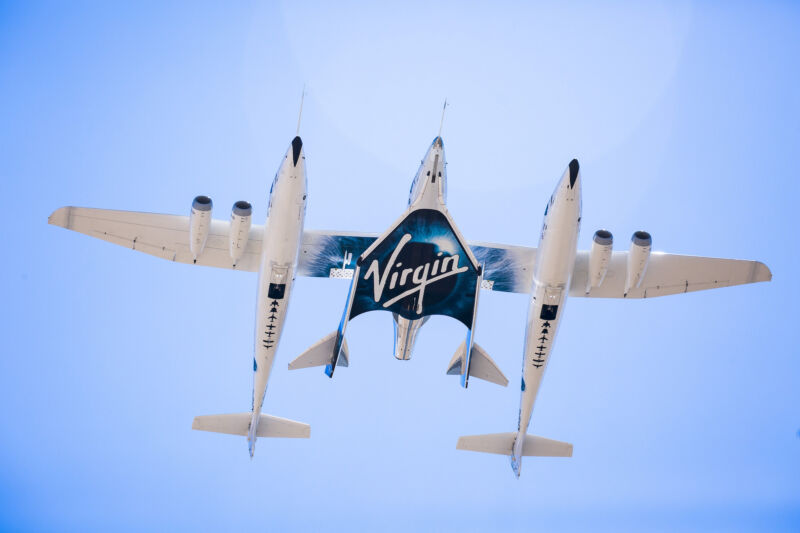After years of setbacks, Virgin Galactic's commercial debut is finally here.
Virgin Galactic is preparing for its first commercial flight to the edge of space on Thursday, with three Italian researchers set to ride a rocket plane on a government-sponsored suborbital research mission over New Mexico alongside three Virgin employees.
The milestone mission comes after more than a decade of test flights of Virgin Galactic’s air-launched rocket-powered vehicles and will be the company’s sixth flight to travel higher than 50 miles (80 kilometers), the boundary of space recognized by NASA and the Federal Aviation Administration.
Virgin Galactic plans to livestream the commercial flight beginning at 11 am EDT (1500 UTC). The company’s large carrier jet, called VMS Eve, will take off from a runway at Spaceport America in New Mexico and climb to an altitude of about 45,000 feet, where it will release the VSS Unity rocket plane to ignite its motor and start the climb to suborbital space.
The rocket motor will fire for about a minute, propelling VSS Unity out of the thick atmosphere on a trajectory that will give the ship’s passengers expansive views of the southwestern United States sprawling under the blackness of space. More importantly, at least for the researchers on Thursday’s flight, the crew in the passenger cabin will be able to unstrap from their seats and float in microgravity for several minutes.
Italian Air Force Col. Walter Villadei, Lt. Col. Angelo Landolfi, and Pantaleone Carlucci, representing the National Research Council of Italy, will be seated behind the pilots in the pressurized cabin of VSS Unity. Colin Bennett, a Virgin Galactic astronaut instructor, will also fly on Thursday’s mission, which the company calls Galactic 01.
The passengers will then return to their seats as the VSS Unity rocket plane reconfigures for descent back into the atmosphere. The vehicle will rotate its dual tail booms toward its fuselage to help slow its reentry, and Virgin Galactic pilots Mike Masucci and Nicola Pecile—on their fourth and first spaceflights, respectively—will steer the vehicle for landing back at the 12,000-foot-long concrete runway (3.7-kilometer) runway at Spaceport America.
Founded by Richard Branson in 2004, Virgin Galactic has endured plenty of setbacks to get to this point. Virgin Galactic and Scaled Composites, led by legendary aircraft designer Burt Rutan, began atmospheric test flights of the “SpaceShipTwo” series of rocket planes in 2010.
In 2014, a fatal crash on a test flight of one of Virgin’s rocket planes killed a pilot employed by Scaled, which designed the vehicle and initially managed the test program. Virgin and Scaled built a suborbital vehicle called VSS Unity to replace the one lost in the crash and started flying it on test missions in 2016.
Branson and a team of Virgin employees soared to an altitude of 53 miles (86 kilometers) on the VSS Unity rocket plane on a highly publicized flight in 2021. Then Virgin Galactic halted its test program for nearly two years for upgrades to the company's carrier aircraft before one more test flight in May to set the stage for Thursday's commercial launch. Another commercial flight by Virgin Galactic is planned in August, followed by monthly revenue-earning suborbital missions.
A sister company called Virgin Orbit, which was originally part of Virgin Galactic, folded earlier this year due to financial difficulties. Virgin Orbit focused on launching small satellites.
First commercial flight focused on research, not sightseeing
Among other research objectives, the Italian crew on Thursday’s flight will perform experiments in biomedical fluid dynamics, combustion, and the behavior of composite structures in microgravity. Villadei, who leads the three-man Italian research team, will wear a “smart flight suit” that Virgin Galactic says is a prototype for garments that future astronauts and space tourists could wear on flights to space.
“VSS Unity will be transformed into a suborbital science lab to provide the environment for rack-mounted payloads and for the crew to interact with wearable payloads,” Virgin Galactic said in its press kit for the Galactic 01 mission.
Villadei is also in training for an orbital flight to the International Space Station with Axiom Space and SpaceX.
The Italian government is paying Virgin Galactic for Thursday’s flight, but officials have not disclosed an exact figure for how much the mission cost. Virgin Galactic says it charges about $450,000 per seat for commercial space tourist missions and has about 800 would-be passengers waiting to fly.

Virgin Galactic and Blue Origin, a competitor in the suborbital space tourism market, have long touted research opportunities for scientists flying to the edge of space on their vehicles. The New Shepard rocket developed by Blue Origin, which was founded by Jeff Bezos, uses a more conventional rocket and capsule design that takes off from the ground and parachutes back to Earth.
Blue Origin started flying paying customers to space in 2021. The New Shepard rocket is capable of boosting passengers higher than Virgin Galactic to an altitude of more than 60 miles (100 kilometers), where international organizations mark the boundary between Earth’s atmosphere and space.
Both companies have suffered failures with their suborbital rockets. Aside from Virgin’s fatal accident in 2014, a Blue Origin rocket failed last year on a mission without any passengers aboard.
NASA has expressed interest in using suborbital flights with Virgin Galactic or Blue Origin to conduct microgravity experiments at a fraction of the cost of a longer-duration orbital mission to the International Space Station.
But for now, the market for suborbital human spaceflight is primarily centered on wealthy customers eager to experience the views and weightlessness that used to be the exclusive domain of professional astronauts and cosmonauts.
The start of Virgin Galactic’s commercial spaceflight service comes a little more than a week after the fatal implosion of the commercial Titan submersible on an expedition to visit the wreck of the Titanic. While there are major differences in the designs of deep-sea submersibles and space vehicles, both need to withstand extreme environments. And the ticket prices are similar for a wealthy adventurer seeking to travel to space or the deep ocean.
The Titan accident in the deep Atlantic Ocean drew comparisons to the risks of human spaceflight. One of the passengers who died on the Titan expedition flew to suborbital space on a Blue Origin rocket last year.
Paying passengers on commercial flights to space currently must sign an “informed consent” document stating that they are aware of the risks of such a mission.
“Government regulators, private operators, insurance companies, lawyers, and lawmakers should pay attention to how this deep ocean disaster plays out and take serious lessons learned for when the private space tourist industry eventually has its ‘Titan moment,’” wrote Brendan Curry, a longtime space policy consultant, in an opinion piece published last week by Space News.
- Karlston
-

 1
1




Recommended Comments
There are no comments to display.
Join the conversation
You can post now and register later. If you have an account, sign in now to post with your account.
Note: Your post will require moderator approval before it will be visible.